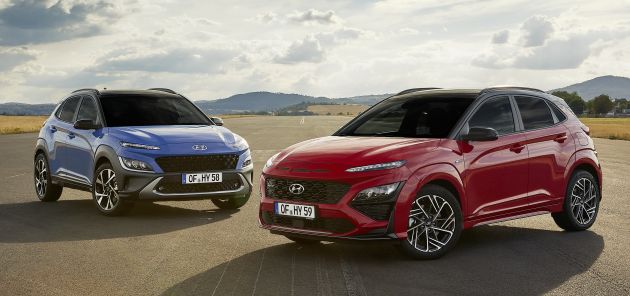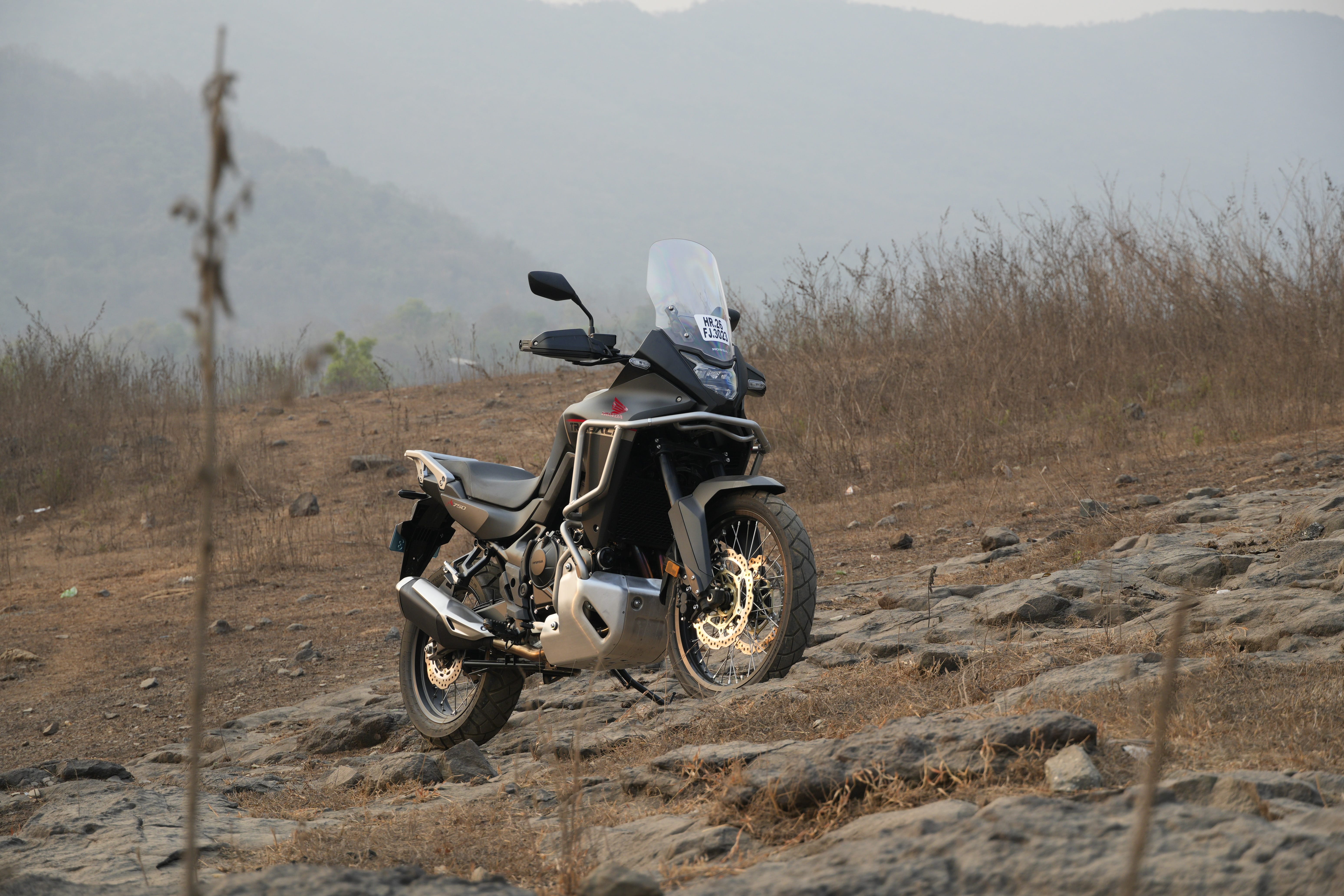Hyundai Kona facelift revealed – now with N Line trim; enhanced powertrains, driver assist, connectivity
The Hyundai Kona has received a midlife facelift that’s said to be driven by customer demand in Europe. The refresh gives the B-segment SUV an altered face as well as new N Line trim option – the latter is very obviously different from the regular Kona facelift, giving the model two distinct faces.
Face aside, the European-market Kona gets an enhanced powertrain line-up (some are sporty, some eco-friendly) plus upgraded connectivity and convenience features. The Kona is also notable for having a well-specced full EV version – the Kona Electric – as well as a hybrid version, but today’s news concerns the regular ICE-powered car.
Why cater to European customers? The “compact SUV for millennials” has been successful in the continent, with over 228,000 units sold there since its debut in 2017. The Kona’s bold design has also received nods from the design community; it scooped up the 2018 iF Design Award, 2018 Red Dot Award and the 2018 IDEA design award, among others.


Let’s start with the biggest change, the face. It’s a heavy rework with a slimmer and wider grille taking centre-stage, the Hyundai logo now sits on the bodywork above the grille (previously in the middle of the face) and the letterbox vent above the grille is no more.
The Kona’s distinctive “eyebrow” LED daytime running lights are still there, but the main beam below now has a scaled appearance. Before this, the black plastic wheel arch cladding fused with the lamp surrounds (front and rear) for “body armour”, but the black bits now fully wrap around the front and rear ends, broken up by a silver chin of a skid plate.
The rear design mirrors this – black across the lower section with a silver central element. The graphics of the tail lamps are new, and the lower tier lights have a new shape that’s more teardrop than before. Lastly, the compact SUV comes with new 17- and 18-inch wheels (16-inch items are carried over), and overall length is 40 mm more due to the new front end.


We move on to the N Line, which looks more like the pre-facelift Kona due to the logo being in the grille. With that, the vent above the grille returns, but is split into three here. Another reason why it appears more like the pre-facelift (despite having the new wide grille) is because the N Line does away with the new full width black cladding, or any cladding for that matter – it’s all body colour here.
In place of the skid plate is an N-style aerodynamic lip with low-lying corner fins, plus larger and “more technical” air intake features. There’s also a unique mesh grille design and unique 18-inch alloys. At the back, no one will miss that huge diffuser with visible twin pipes (no visible pipes on the regular car). The rear corners sport small fins for better air flow.
The latest Kona comes with five new exterior colours – Surfy Blue, Dive in Jeju, Ignite Flame, Cyber Gray and Misty Jungle – to make it 10 options in total. All can be combined with a black roof and matching wing mirror caps.
Hyundai says that the goal for the interior was to project more sophistication and to improve perceived quality, which is perhaps why the dashboard appears more solid and sombre than funky. The basic architecture remains, but the console area is now disconnected from the centre stack to stress the horizontal layout.
The rings around the speakers and air vents get an aluminium finish, while new additions include an electric parking brake and ambient lighting for the centre cupholders and front foot wells. There are also new colours and materials including a black woven houndstooth design for the seats. Not everyone likes black, so there’s a light beige option for the cabin and available khaki leather seats with matching brown centre console.
N Line cars come with a black interior with cloth, leather or suede seats. Red stitching, metal pedals, and N emblems on the steering wheel, gear knob and seats add to the sportier feel.
For tech and connectivity, the latest Kona gets the 10.25-inch digital cluster that was first seen in the new i20. This can be paired to a 10.25-inch AVN screen with a split-screen function and multiple Bluetooth connections. The latest Bluelink upgrade includes Last Mile Navigation, Connected Routing, Live Parking Information and Free Text Search. Voice recognition now includes climate, rear window and side mirror heating and steering wheel heating.
The regular Display Audio system is now at eight inches (from seven) and supports wireless Android Auto and Apple CarPlay.
The safety and driving assist department gets a big upgrade. Smart Cruise Control (SCC) has been upgraded to include the stop and go function. Blind-Spot Collision-Avoidance Assist (BCA), available in combination with the DCT, now engages the car’s differential brakes to prevent a collision in the blind spot.
The new Leading Vehicle Departure Alert (LVDA) alerts the driver if they do not react fast enough when the vehicle ahead of them starts moving. Lane Following Assist (LFA) helps the driver to keep the Kona in the centre of the lane.
The camera-based Forward Collision-Avoidance Assist (FCA) with pedestrian detection is standard, but there’s a new optional cyclist detection with a sensor in addition to the camera. This increases the detection range and the types of targets, Hyundai says, adding that it ensures the system works in bad weather. Rear Cross-Traffic Collision-Avoidance Assist (RCCA), also a first for the Kona (with the DCT), applies the brakes when reversing out onto traffic. The previous version only provided a warning.
Another unique feature is Rear Seat Alert (RSA), which alerts the driver if someone (or something) is in the back seat when they exit the vehicle. You know, in case you forget your child. Another safety feature aimed at kids, Safe Exit Warning (SEW) is intended to prevent passengers from exiting the car if it is not yet safe to do so. There’s also Intelligent Speed Limit Warning (ISLW shows current speed limit in the cluster and AVN, with warning) and eCall, which automatically alerts emergency services if the airbags are deployed or the e-Call button is pushed.
The powertrain line-up is topped by an enhanced 1.6L T-GDI Smartstream engine with a seven-speed dual clutch transmission. This 198 PS option can be in 2WD or 4WD. 48-volt mild hybrid tech is applied to the 1.6L Smartstream diesel with 136 PS. This can be had with a seven-speed DCT or six-speed Intelligent Manual Transmission (iMT), as well as optional 4WD.
The base 1.0L T-GDI Smartstream petrol engine with 120 PS can also be equipped with the mild hybrid tech and 6iMT. Without the mild hybrid tech, the 1.0L T-GDI can be combined with the DCT or a regular six-speed manual gearbox.
First seen in the 2020 i30 and new i20, the iMT’s clutch operates electronically instead of using a mechanical linkage. The iMT decouples the engine from the transmission after the driver releases the accelerator, saving fuel as the engine can switch off and the car enters into coasting mode. The engine restarts in the same gear as soon as the driver presses either the brake or gas pedals, thanks to power provided by the mild hybrid starter generator.


Hyundai says that the new Kona has a smoother ride. Next to retuned springs and dampers, the stabiliser bars and rear bump stops were also modified for better primary ride and lateral body control.
The SUV will come with the latest tyres on all sizes of wheels for less rolling resistance, while the 18-inch option is now the Conti Premium Contact 6, a ride comfort upgrade from the previous CSC5s. NVH has also been improved, the Korean carmaker claims. Steering has been fine-tuned to match the new suspension setting and tyres.
Finally, Hyundai has added second row heated seats and a second-row USB port. The front row passenger manual seat is now height adjustable. The Kona facelift and N Line will hit European showrooms towards the end of 2020, while the hybrid version is set to launch in early 2021. The revised Kona Electric, which will carry over the powertrain and electric range of today’s EV, will be revealed in the near future.
The Hyundai Kona’s Malaysian launch is just around the corner, and here’s what we’re going to get, from RM115k.
GALLERY: Hyundai Kona facelift









GALLERY: Hyundai Kona facelift N Line









GALLERY: Hyundai Kona pre-facelift





























The post Hyundai Kona facelift revealed – now with N Line trim; enhanced powertrains, driver assist, connectivity appeared first on Paul Tan's Automotive News.
from Paul Tan's Automotive News
Read The Rest:paultan...










Post a Comment